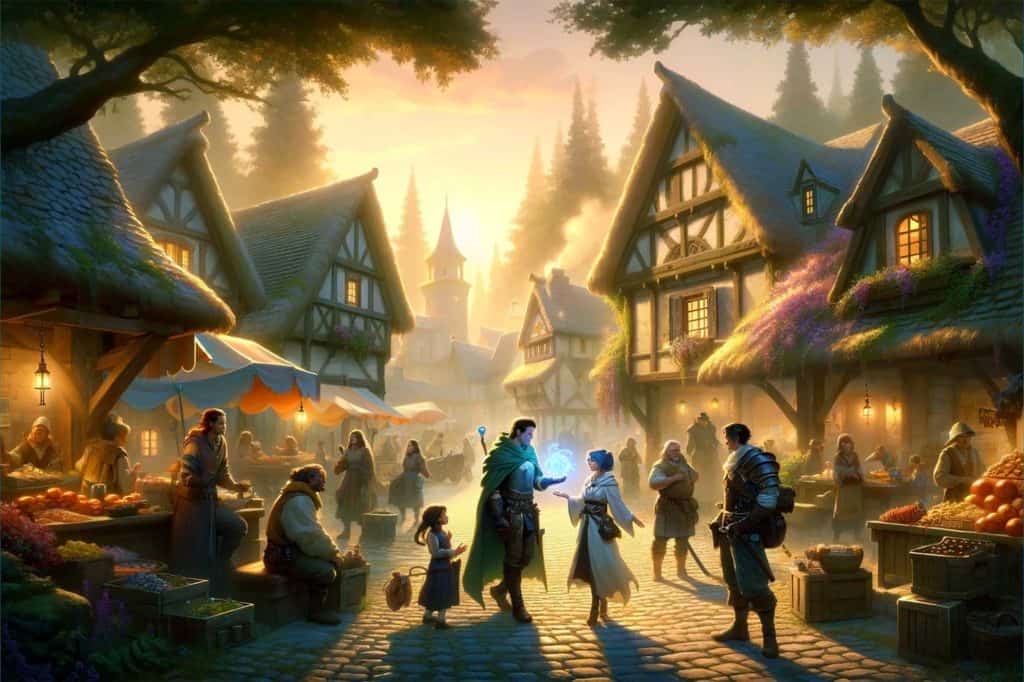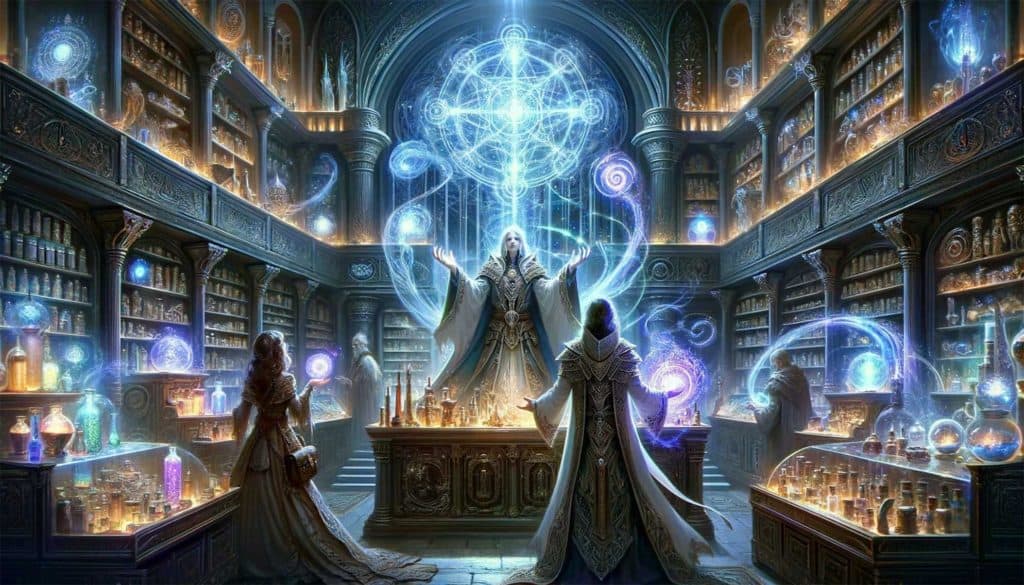In the realm of Dungeons & Dragons, the clashing of swords and the casting of spells often take center stage, captivating players with thrilling combat encounters. However, there lies a vast, often uncharted territory beyond these battlefields: the world of non-combat scenarios. These scenarios, ranging from intricate diplomatic negotiations to mind-bending puzzles and in-depth role-playing, offer a rich tapestry of experiences that can deeply enhance a D&D campaign.
Balancing the high-octane excitement of combat with the nuanced complexities of non-combat scenarios is not just a matter of variety; it’s about crafting a more immersive and multi-dimensional world. A world where players’ choices, characters’ backgrounds, and the unfolding narrative carry as much weight as their prowess in battle. This balanced approach allows for a more rounded gaming experience, where strategy, diplomacy, and character development become as crucial as strength and agility.
Throughout this exploration, we will delve into the various facets of non-combat scenarios. From the subtle art of diplomacy, which requires players to navigate complex political landscapes, to the intellectual challenges posed by puzzles and riddles, and the depths of character-driven role-play. Each element plays a vital role in enriching the D&D experience, providing avenues for creativity, problem-solving, and storytelling.
As we journey through this guide, we will uncover the secrets to designing compelling non-combat encounters, integrating them seamlessly into your campaigns, and striking the perfect balance between the clash of swords and the power of words. So, gather your notes and ready your imagination, as we venture beyond the sword and sorcery into the heart of what makes D&D truly enchanting.
The Art of Diplomacy in D&D
In the multifaceted world of Dungeons & Dragons, diplomacy stands as a cornerstone of many memorable campaigns. It’s an art that transcends mere conversation, inviting players and Dungeon Masters (DMs) alike to engage in a dance of intrigue, persuasion, and negotiation. Crafting diplomatic encounters and political intrigue not only adds depth to the narrative but also provides a stage for players to showcase their characters’ wit, charisma, and strategic thinking.
Designing Diplomatic Challenges
Creating a compelling diplomatic scenario is akin to weaving a tapestry of interconnected threads. It involves constructing a political landscape rich with allies, adversaries, and neutral parties, each with their own agendas and secrets. The key lies in making these encounters engaging and challenging, yet fair. This can be achieved by establishing clear objectives, potential consequences, and multiple paths to success, thus maintaining player agency and ensuring the story progresses in a meaningful way.
Try my AI Tabletop RPG generators...and an extensive library of content!
Consider a scenario where players must negotiate peace between warring factions. The complexity arises not just from the negotiation itself, but from understanding each faction’s motivations, leveraging alliances, and perhaps even engaging in a bit of espionage. Such scenarios encourage players to think critically about their actions and their impact on the world, pushing the boundaries of what it means to be a hero in D&D.

The World of Puzzles and Riddles
Venture beyond the battlefield and into the realm of the mind, where puzzles and riddles await to challenge and delight players in Dungeons & Dragons. These mental trials add a layer of intellectual intrigue to a campaign, offering a refreshing break from physical combat. They serve not only as entertaining brain teasers but also as gateways to deeper lore, hidden treasures, and crucial plot developments.
Crafting the Perfect Puzzle
Designing an engaging puzzle requires a delicate balance between challenge and accessibility. The puzzle should be complex enough to provide a sense of achievement upon solving, but not so arcane that it halts the progress of the game. It’s essential to align puzzles with the campaign’s theme and the players’ abilities, ensuring that they enhance the story rather than detract from it.
For instance, a puzzle in an ancient wizard’s tower might involve arcane symbols and magical elements, while one in a rogue’s hideout could revolve around stealth and cunning. The key is to make the puzzle feel like an integral part of the world, not an out-of-place obstacle. It’s also important to consider the mechanics of the puzzle—whether it involves logic, pattern recognition, or physical manipulation—and how it can reveal lore, offer rewards, or advance the plot when solved.
⚔️ Fantasy RPG Random Tables Books
Make life as a Gamemaster easier…
If you play Dungeons & Dragons, Pathfinder, or other fantasy RPGs, this
RPG random tables series
is packed with encounters, NPCs, treasure, and more. Available in eBook or print—either way, you’ll have a wealth of adventure ideas at your fingertips.
By thoughtfully incorporating puzzles and riddles, DMs can stimulate players’ creativity and problem-solving skills, adding another dimension to the adventure.
Emphasizing Role-Playing and Character Development
Role-playing is the heartbeat of Dungeons & Dragons, providing a stage for players to breathe life into their characters beyond combat encounters. In non-combat scenarios, deep role-playing opportunities abound, allowing players to explore their characters’ personalities, backgrounds, and motivations. These moments, often filled with meaningful dialogues and moral dilemmas, can lead to significant character development and forge lasting memories.
Nurturing Role-Playing Skills
As a Dungeon Master, facilitating immersive role-playing experiences is both an art and a skill. It’s about creating scenarios that not only challenge the characters but also resonate with the players, encouraging them to delve deeper into their roles. Here are some strategies to enhance role-playing in your campaign:
- Set the Scene: Provide rich descriptions and context to help players visualize and engage with the scenario.
- Encourage Backstory Integration: Design scenarios that tie into the characters’ backstories, giving players a chance to explore and reveal more about their characters.
- Offer Meaningful Choices: Create situations where players must make decisions that reflect their characters’ morals and goals.
- Use NPCs Effectively: Develop well-rounded NPCs with their own motivations and personalities to interact with the players.
- Facilitate Emotional Engagement: Craft scenarios that evoke a range of emotions, from joy to sorrow, anger to empathy.
- Reward Creative Solutions: Acknowledge and reward players for unique and creative approaches to role-playing challenges.
After setting the stage for deeper engagement, remember to step back and allow the players to take the reins. This empowers them to drive the narrative forward, making the role-playing experience more authentic and memorable.
Role-playing, when nurtured and encouraged, transforms a typical D&D session into a rich, collaborative storytelling experience. It elevates the game from a series of encounters and dice rolls to an immersive journey into a vividly imagined world.
Balancing Combat and Narrative
Striking the right balance between combat and non-combat elements is crucial for a well-rounded Dungeons & Dragons campaign. This equilibrium ensures that the game remains engaging for all players, regardless of their individual preferences. It’s about creating a seamless narrative that weaves together high-stakes battles and thoughtful non-combat scenarios, each complementing the other to enrich the overall experience.
Tailoring the Campaign to Your Players
Understanding and adapting to your players’ dynamics and preferences is key to maintaining this balance. Here are some strategies to help you tailor your campaign:
- Assess Player Preferences: Engage with your players to understand what aspects of the game they enjoy most. Some may relish combat, while others might prefer role-playing or problem-solving.
- Adapt Storytelling to Suit Playstyles: Be flexible in your storytelling. If your players enjoy intricate political plots, weave more diplomatic encounters into the narrative. If they prefer puzzles, incorporate challenging riddles and brain teasers.
- Incorporate Feedback: Regularly seek feedback from your players. This can help you gauge whether the balance feels right and make adjustments as needed.
Every group is unique, and what works for one set of players may not resonate with another. The key is to remain attentive and adaptable, ready to modify the campaign to suit the evolving interests and playstyles of your group.
Balancing combat with narrative and non-combat scenarios doesn’t just make for a more enjoyable game; it also creates a richer and more diverse world. It allows players to explore different facets of their characters and the campaign setting, leading to a more fulfilling and memorable D&D experience.

Conclusion: Non-Combat DND
As our expedition through the diverse landscapes of Dungeons & Dragons draws to a close, we reflect on the vibrant tapestry of non-combat scenarios that enrich this beloved game. From the intricate dance of diplomacy to the cerebral delights of puzzles and the deep waters of character-driven role-play, each element adds a unique hue to the D&D canvas. Integrating these aspects not only diversifies the gameplay but also elevates the storytelling, making each campaign a distinct and memorable journey.
⚔️ Fantasy RPG Random Tables Books
Make life as a Gamemaster easier…
If you play Dungeons & Dragons, Pathfinder, or other fantasy RPGs, this
RPG random tables series
is packed with encounters, NPCs, treasure, and more. Available in eBook or print—either way, you’ll have a wealth of adventure ideas at your fingertips.
The art of balancing combat with these narrative-rich scenarios is akin to a skilled bard weaving a tale. It requires an understanding of your audience – the players – and a keen sense of timing and pacing. As Dungeon Masters, our challenge is to harmonize these elements, crafting campaigns that resonate with the hearts and minds of our players, providing both challenges and rewards in equal measure.
This exploration is but a glimpse into the vast possibilities that non-combat scenarios offer. As you venture forth in your D&D adventures, remember to embrace the full spectrum of experiences. Experiment with different scenarios, adapt to your players’ evolving interests, and above all, foster an environment where creativity and storytelling flourish.
May your campaigns be rich with intrigue, your puzzles be cleverly crafted, and your role-playing moments be deeply immersive. Here’s to creating unforgettable adventures that go beyond the sword and sorcery, into the realms of imagination and wonder.










